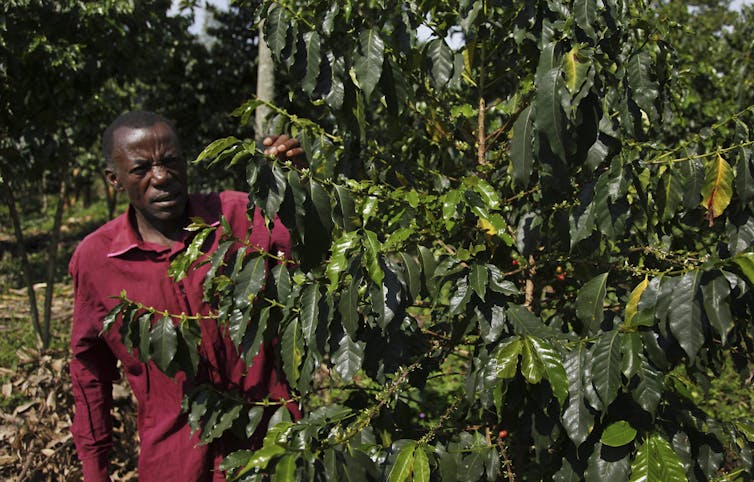This article was originally published on , which features includes relevant and informed articles, written by researchers and academics in their areas of expertise and edited by experienced journalists.
is a professor in food distribution and policy at
Fall is always a good time to create new habits, and coffee chains know it.
These days, they are desperately trying to find any excuse to get you to drink their java.
Many chains used earlier this year as a reason to offer their coffee at a discount, or even for free — with some conditions, of course.
For restaurant operators, there’s to get repeat business. It’s a great scheme that seems to be working for some. Given what’s looming on the horizon, however, offering free coffee may no longer be an option for businesses.
Coffee demand around the world is shifting. Europe still accounts for almost worldwide, but China in just the last five years.
As for Canada, as more than 90 per cent of adult Canadians drink coffee. Several recent studies suggest coffee is a healthy choice, possibly one factor in the rise in coffee drinkers.
Either way, demand is strong in most Western countries, which puts more pressure on coffee-producing countries. However, as climate change looms, there’s a real threat to coffee’s global success story.
Coffee grown in more than 60 countries
Coffee is after oil.
Coffee beans are grown in more than 60 countries and allow 25 million families worldwide to make a living. Brazil is by far the largest producer, followed by Vietnam and Colombia.
Globally, 2017 could be a record year, as the world will likely produce well over 153 million 60-kilogram bags of coffee. Coffee futures but we are far from seeing a bumper crop.
Production has been modestly shifting over the past few years. With good rainfalls in Brazil and favourable weather patterns in other regions of the world, Mother Nature has so far spared coffee growers, but their luck may be running out.
Despite not being a staple in any diet, coffee is big business. coffee is worth over US$100 billion. In the retail sector, the coffee industry is worth US$10 billion.
But there is that climate change will severely affect coffee crops over the next 80 years. By 2100, more than 50 per cent of the land used to grow coffee will no longer be arable.
Ethiopia could be profoundly affected
A combination of effects, resulting from higher temperatures and shifting rainfall patterns, will make the land where coffee is currently grown unsuitable for its production.
According to the , in Latin America alone, more than 90 per cent of the land used for coffee production could suffer this fate. It’s estimated that Ethiopia, the sixth largest producer in the world, could lose over 60 per cent of its production by 2050. That’s only a generation from now.
As climate conditions become critical, the livelihoods of millions of farmers are at risk and production capacity is jeopardized. Other potential contributors to this predicted downfall are pests and diseases.

With climate change, pest management and disease control are serious issues for farmers who cannot afford to protect their crops. More than 80 per cent of coffee growers are peasant farmers.
Pests and diseases will migrate to regions where temperatures are adequate for survival, and most farmers won’t be ready. Many will simply choose to grow other crops less vulnerable to climate change. Others may attempt to increase their coffee production, but the quality will almost certainly be compromised.
Coffee quality will suffer
Higher temperatures will affect the quality of coffee. Higher-quality coffee is grown in specific regions of the world where the climate allows the beans to ripen at just the right time. Arabica coffee, for example, which represents 75 per cent of world coffee production, is always just a few degrees away from becoming a sub-par product.
This will undoubtedly affect coffee prices and quality for us all. Thanks to the so-called Starbucks Effect, the quality of the coffee we now enjoy is far superior to that of just a decade ago. Good beans may become more difficult to procure in the future.
Right now, coffee futures are valued at US$1.28 per pound and are being exposed to downward pressures. At this rate, , set in 1977, could return in just a few years.
The coffee wars we are seeing are not just about gaining market shares and getting consumers hooked on java. They are also about how we connect with a crop that is under siege by climate change.
Short of fighting climate change, we could be forced to alter our relationship with coffee. As current coffee-producing countries attempt to develop eco-friendly methods and embrace sustainable practices, Canada could be the next country where coffee is actually grown, not just roasted.
Within the next decade, with climate change and new technologies, perhaps producing coffee beans will be feasible in Canada. After all, if Elon Musk thinks by 2022, why can’t we grow coffee in Canada?
![]() So if a coffee chain is offering free coffee, take it. It won’t be long before coffee could become a luxury.
So if a coffee chain is offering free coffee, take it. It won’t be long before coffee could become a luxury.
Read the on The Conversation.
���ϳԹ��� is a founding partner of The Conversation Canada, a new-to-Canada online media outlet providing independent, high-quality explanatory journalism. Originally established in Australia in 2011, it has had more than 85 commissioning editors and 30,000-plus academics register as contributors. A full list of articles written by ���ϳԹ���academics can be found on .

